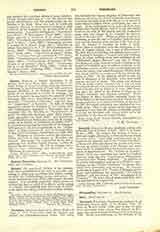

Coronado, FRANCISCO VASQUEZ DE, explorer, b. at Salamanca, Spain, 1500; d. in Mexico, 1553. He went to Mexico before 1538, and is said to have been a favorite of the viceroy Don Antonio de Mendoza, who appointed him Governor of New Galicia in 1538. In the year following, on the strength of The statements of Cabeza de Vaca and other vague reports, the viceroy sent Father Marcos of Nizza with the negro or Moor Estevanico to reconnoitre towards the north. The friar coming back with the news that sedentary Indians had been met beyond what are now the limits of Mexico, an expedition was determined upon and Coronado was made commander.
One of the chief objects of this expedition seems to have been to free Mexico from an idle and unruly element. Hence exaggerated accounts of the northern regions, of the culture of their inhabitants, and of their mineral resources, were purposely spread abroad. Whether or not Coronado knew of this object is not stated. The expedition collected at Compostella on the Pacific coast, and consisted of about 300 Spaniards and 1000 Indians, with 1000 horses and six swivel guns (pedereros). There were also a number of sheep and some cattle, and everything indicated that the intention was not only to explore but to colonize. In the course of two years Coronado visited almost every New Mexican pueblo then inhabited. The first of the pueblo groups touched was what is now called Zuni, which had become known to the Spaniards through Father Marcos of Nizza the year previous under the name of “Cibola”. The first engagement took place about July 7, at the village of Hauicu of the Zuni group. Coronado was wounded, but the pueblo taken. After that, only one other conflict with Pueblo Indians occurred, viz., near Bernalillo, in New Mexico, on the Rio Grande, in March, 1541. The conduct of Coronado towards the Indians during the whole campaign was humane and he secured their respect and sympathy. New Mexico and Arizona (which he explored as far as the Colorado River) disappointed the expectations of the Spaniards. The wealth in metals supposed to exist there was not found, the inhabited regions were partly barren, and the population less numerous than it had been represented. While Coronado was establishing himself at Zuni, another expedition, by sea, under the command of Hernando de Alarcon, reached the mouth of the Colorado and explored the course of the river for about two hundred miles inland, but found it impossible to communicate with Coronado, and returned to the Mexican coast.
While at the pueblo of Pecos, southeast of the present city of Santa Fe, the Spaniards had been told glowing stories of metallic riches among a tribe called Quivira, said to dwell beyond the great eastern plains. These tales were reported by an Indian from the plains, a captive among the Pecos tribe. Coronado set out for Quivira on April 23, 1541, with part of his forces, and wandered as far as the confines of Arkansas, then northward as far as southern Nebraska, finding none but nomadic Indians, except at the farthest point reached by him, where the Quivira Indians lived in more stable settlements of houses, round in shape and built of wood, with roofs of grass. They cultivated corn, and the only trace of metal was a piece of native copper which they had obtained from afar. After an absence of six months Coronado returned to New Mexico on the Rio Grande, and while there suffered a fall from his horse, which injured his head seriously. Henceforward he lost energy. His people also were discouraged and, while some were in favor of remaining in New Mexico, the majority clamored to return to New Spain. In April, 1542, the homeward march was resumed. There remained in the country only Fray Juan de Padilla, a lay brother, Fray Luis, and a Portuguese soldier, Docampo. Coronado reported to the Viceroy Mendoza, who was highly incensed at the failure of his plan to rid New Spain of undesirable elements. Although Coronado was not punished for what was looked upon as disobedience to orders, he fell into a mild disgrace and died in comparative obscurity, leaving a widow and eight children. The reports on his expedition are of the greatest importance for the geography, and more particularly ethnography, of the southwestern part of North America. They were not so well appreciated at the time as they are now, when the “March” of Coronado is looked upon as one of the most important explorations in America during the sixteenth century.
AD. F. BANDELIER

